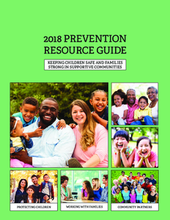About the Resource Guide
This Resource Guide was developed to support service providers in their work with parents, caregivers, and their children to prevent child abuse and neglect and promote child and family well-being. It was created by the U.S. Department of Health and Human Services’ Children’s Bureau, Office on Child Abuse and Neglect, its Child Welfare Information Gateway, and the FRIENDS National Center for Community-Based Child Abuse Prevention. The resources featured represent the work of a broad-based partnership of national organizations, federal partners, and parents committed to strengthening families and communities.
What’s Inside
The Resource Guide was created primarily to support community-based child abuse prevention professionals who work to prevent child maltreatment and promote well-being. However, others—including policymakers, parent educators, family support workers, health-care providers, program administrators, teachers, child care providers, mentors, and clergy—also may find the resources useful. The following resources are included in this guide:
Chapter 1: Strengthening Individuals, Families, and Communities—Information about protective factors that help reduce child abuse and neglect, established protective factors approaches, and how state and local agencies are implementing protective factors approaches to create lasting change in how communities support families.
Chapter 2: Working With Families Using the Protective Factors—Detailed information about six protective factors for preventing child maltreatment and tips and examples for infusing them into programs and direct practice with families and children. At the end of this chapter, sample scenarios illustrate how multiple protective factors support and strengthen families who are experiencing stress.
Chapter 3: Using Protective Factors as a Framework for Your Community Partnership— Strategies to help build community awareness and support the development of broad-based, meaningful community partnerships.
Chapter 4: Protecting Children—Information about why child abuse occurs, risk factors, consequences, identifying and reporting maltreatment, the relationship between adverse childhood experiences and well-being, tips for working with parents and children with a history of trauma, how to support immigrant and refugee families, and how to identify and respond to human trafficking.
Chapter 5: Tip Sheets for Parents and Caregivers—Strengths-based tip sheets on specific parenting topics that can be used in discussions or visits with caregivers.
Chapter 6: Resources—Contact information for private and federal partners working nationally to strengthen families.
This resource guide has information in English and in Spanish.

